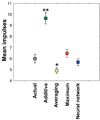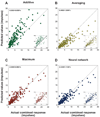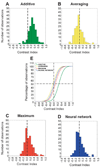A neural network model of multisensory integration also accounts for unisensory integration in superior colliculus
- PMID: 18486113
- PMCID: PMC2824893
- DOI: 10.1016/j.brainres.2008.03.074
A neural network model of multisensory integration also accounts for unisensory integration in superior colliculus
Abstract
Sensory integration is a characteristic feature of superior colliculus (SC) neurons. A recent neural network model of single-neuron integration derived a set of basic biological constraints sufficient to replicate a number of physiological findings pertaining to multisensory responses. The present study examined the accuracy of this model in predicting the responses of SC neurons to pairs of visual stimuli placed within their receptive fields. The accuracy of this model was compared to that of three other computational models (additive, averaging and maximum operator) previously used to fit these data. Each neuron's behavior was assessed by examining its mean responses to the component stimuli individually and together, and each model's performance was assessed to determine how close its prediction came to the actual mean response of each neuron and the magnitude of its predicted residual error. Predictions from the additive model significantly overshot the actual responses of SC neurons and predictions from the averaging model significantly undershot them. Only the predictions of the maximum operator and neural network model were not significantly different from the actual responses. However, the neural network model outperformed even the maximum operator model in predicting the responses of these neurons. The neural network model is derived from a larger model that also has substantial predictive power in multisensory integration, and provides a single computational vehicle for assessing the responses of SC neurons to different combinations of cross-modal and within-modal stimuli of different efficacies.
Figures







References
-
- Alvarado JC, Vaughan JW, Stanford TR, Stein BE. Multisensory versus unisensory integration: contrasting modes in the superior colliculus. J. Neurophysiol. 2007a;97(5):3193–3205. - PubMed
-
- Calvert GA, Spence C, Stein BE. The Handbook of the Multisensory Processes. Cambridge, MA: MIT Press; 2004.
Publication types
MeSH terms
Grants and funding
LinkOut - more resources
Full Text Sources

